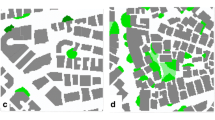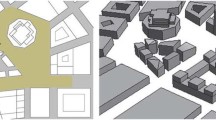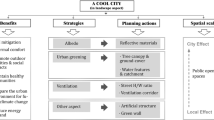Abstract
Urban and microclimate have an intense relationship that affects each other. The specific urban structure can affect microclimate because of the high radiation generated. On the other side, urban structure blocks the distribution of incoming wind. Urban structure changes how the microclimate influences the city. The successful urban structure can impact how outdoor open spaces are used meanwhile good open spaces are affected by how comfortable can be accepted. In addition, water and greenery space is an essential urban part and has a vital environmental implication in alleviating the urban heat island (UHI). This chapter analysed thermal comfort in cold coastal areas and tropical areas. Especially in the cold coastal areas, this chapter chooses 3 plots of land used for education, 2 used as parks, 6 for commercial use, 2 for industrial land, 11 for residential land, and 6 for other land-use types. Because the field measurement points are scattered throughout the city, and the numbers of measurement instruments and researchers are limited, the 30 points are divided into five groups. Through simultaneous tests at the same period and time interval, the degree of difference in the urban thermal environment under different land categories and building types is analyzed. Through research, we found that the coupling relationship between outdoor environmental performance (OEP) and BH is analyzed qualitatively at different ranges. The maximum R2 is 0.9052, the minimum is 0.3813, and the average is 0.80, indicating an apparent quadratic polynomial relationship between AT and BH within 500 m. In addition, the coupling strength between BH and RH is relatively high. The coupling relationship between AT and BH appears to be the opposite of RH and BH. The data are also highly discrete, so there is no clear relationship between BH and WS. Coupling strength in the range of 100 m, 300 m, 700 m, and 900 m is not as strong as that of 500 m, showing higher data dispersion and a smaller R2 value. So urban structures must be well designed to make wind release the heat trapped in the urban area. This chapter also takes urban green infrastructure of Tianjin in China as a case, using subjective and objective analysis and model simulation. Waterfront compound greenery’s cooling effect was found more significant at waterfront 3–6 m, where the location was suitable for construction. When the green lawn of the waterfront space was 12 m and the water shore’s geometric form was S-shaped, this could improve the cooling effect of water significantly. This chapter provides practical implications and useful guidance for the urban planning and design.
Access this chapter
Tax calculation will be finalised at checkout
Purchases are for personal use only
Similar content being viewed by others
References
Urban MC (2015) Accelerating extinction risk from climate change[J]. Science 348(6234):571–573
Huang L, Jia GS, Fang SB et al (2021) Big earth data for UN sustainable development goals: climate change and action. Bull Chin Acad Sci 36(08):923–931
Li ZX (2022) Transforming our world: the 2030 agenda for sustainable development [EB/OL]. (2017-01-22) [2022-4-28]. http://blog.sciencent.cn/blog-3017-1029313.html
The United Nations predicts that the urban population will reach 66% of the world's total population by 2050[EB/OL] (2018) http://world.people.com.cn/n1/2018/0327/c100229892014.html
Rees W, Wackernagel M (2008) Environmental sustainability Urban ecological footprints: why cities cannot be sustainable-and why they are a Key to sustainability. Urban Ecology V:537–555. https://doi.org/10.1007/978-0-387-73412-5_35
Brozovsky J, Gaitani N, Gustavsen A (2021) A systematic review of urban climate research in cold and polar climate regions. Renew Sustain Energy Rev 138:110551. https://doi.org/10.1016/j.rser.2020.110551
Zhou D, Xiao J, Bonafoni S et al (2019) Satellite remote sensing of surface Urban Heat Islands: Progress, challenges, and perspectives. Remote Sens 11:48. https://doi.org/10.3390/rs11010048
Mao Q, Peng J, Wang Y (2021) Resolution enhancement of remotely sensed land surface temperature: current status and perspectives. Remote Sens 13:1306. https://doi.org/10.3390/rs13071306
Crommelinck S, Bennett R, Gerke M et al (2016) Review of automatic feature extraction from high-resolution optical sensor data for UAV-based cadastral mapping. Remote Sens 8:689. https://doi.org/10.3390/rs8080689
Vélez-Nicolás M, García-López S, Barbero L et al (2021) Applications of unmanned aerial systems (UASs) in hydrology: a review. Remote Sens 13:1359. https://doi.org/10.3390/rs13071359
Fei F, Wang Y, Yao W et al (2022) Coupling mechanism of water and greenery on summer thermal environment of waterfront space in China's cold regions. Build Environ 214:108912. https://doi.org/10.1016/j.buildenv.2022.108912
Tsoka S, Tsikaloudaki A, Theodosiou T (2018) Analyzing the ENVI-met microclimate model’s performance and assessing cool materials and urban vegetation applications–a review. Sustain Cities Soc 43:55–76. https://doi.org/10.1016/j.scs.2018.08.009
Erell E, Pearlmutter D, Williamson TJ (2011) Urban microclimate: designing the spaces between buildings. Earth
Su Y, Wang Y, Wang C et al (2022) Coupling relationships between urban form and performance of outdoor environment at the pedestrian level[J]. Build Environ 213:108514
Berndtsson JC, Bengtsson L, Jinno K (2009) Runoff water quality from intensive and extensive vegetated roofs. Ecol Eng 35:369–380. https://doi.org/10.1016/j.ecoleng.2008.09.020
Kondoh A, Nishiyama J (2000) Changes in hydrological cycle due to urbanization in the suburb of Tokyo metropolitan area. Japan Advances in Space Research 26:1173–1176. https://doi.org/10.1016/S0273-1177(99)01143-6
Nasrollahi N, Ghosouri A, Khodakarami J et al (2020) Heat-mitigation strategies to improve pedestrian thermal comfort in Urban environments: a review. Sustainability 12:10000. https://doi.org/10.3390/su122310000
Huang Q, Meng X, Yang X et al (2016) The Ecological City: considering outdoor thermal environment. Energy Procedia 104:177–182. https://doi.org/10.1016/j.egypro.2016.12.031
Taleghani M, Berardi U (2018) The effect of pavement characteristics on pedestrians’ thermal comfort in Toronto. Urban Clim 24:449–459. https://doi.org/10.1016/j.uclim.2017.05.007
Bowler DE, Buyung-Ali L, Knight TM et al (2010) Urban greening to cool towns and cities: a systematic review of the empirical evidence. Landsc Urban Plan 97:147–155. https://doi.org/10.1016/j.landurbplan.2010.05.006
Sun R, Lü Y, Yang X et al (2019) Understanding the variability of urban heat islands from local background climate and urbanization. J Clean Prod 208:743–752. https://doi.org/10.1016/j.jclepro.2018.10.178
Gago EJ, Roldan J, Pacheco-Torres R et al (2013) The city and urban heat islands: a review of strategies to mitigate adverse effects. Renew Sust Energ Rev 25:749–758. https://doi.org/10.1016/j.rser.2013.05.057
Lai D, Liu W, Gan T et al (2019) A review of mitigating strategies to improve the thermal environment and thermal comfort in urban outdoor spaces. Sci Total Environ 661:337–353. https://doi.org/10.1016/j.scitotenv.2019.01.062
Zhao TF, Fong KF (2017) Characterization of different heat mitigation strategies in landscape to fight against heat island and improve thermal comfort in hot–humid climate (part I): measurement and modelling. Sustain Cities Soc 32:523–531. https://doi.org/10.1016/j.scs.2017.03.025
Zhou XF, Zhang S, Zhu D (2021) Impact of Urban water networks on microclimate and PM2.5 distribution in downtown areas: a case study of Wuhan. Build Environ 203:108073. https://doi.org/10.1016/j.buildenv.2021.108073
Xu JC, Wei QL, Huang XF et al (2010) Evaluation of human thermal comfort near urban waterbody during summer. Build Environ 45:1072–1080. https://doi.org/10.1016/j.buildenv.2009.10.025
Sun R, Chen L (2012) How can urban water bodies be designed for climate adaptation? Landsc Urban Plan 105:27–33. https://doi.org/10.1016/j.landurbplan.2011.11.018
Morille B, Musy M (2017) Comparison of the impact of three climate adaptation strategies on summer thermal comfort–cases study in Lyon. France Procedia Environmental Sciences 38:619–626. https://doi.org/10.1016/j.proenv.2017.03.141
Martins TAL, Adolphe L, Bonhomme M et al (2016) Impact of Urban cool island measures on outdoor climate and pedestrian comfort: simulations for a new district of Toulouse, France. Sustainable Cities and Society 26:9–26. https://doi.org/10.1016/j.scs.2016.05.003
Van Hove LWA, Jacobs CMJ, Heusinkveld BG et al (2015) Temporal and spatial variability of urban heat island and thermal comfort within the Rotterdam agglomeration. Build Environ 83:91–103. https://doi.org/10.1016/j.buildenv.2014.08.029
Hathway EA, Sharples S (2012) The interaction of rivers and urban form in mitigating the Urban Heat Island effect: a UK case study. Build Environ 58:14–22. https://doi.org/10.1016/j.buildenv.2012.06.013
Steeneveld GJ, Koopmans S, Heusinkveld BG et al (2014) Refreshing the role of open water surfaces on mitigating the maximum urban heat island effect. Landsc Urban Plan 121:92–96. https://doi.org/10.1016/j.landurbplan.2013.09.001
Ballinas M, Barradas VL (2016) Transpiration and stomatal conductance as potential mechanisms to mitigate the heat load in Mexico City. Urban For Urban Green 20:152–159. https://doi.org/10.1016/j.ufug.2016.08.004
Wu C, Li J, Wang C et al (2019) Understanding the relationship between urban blue infrastructure and land surface temperature. Sci Total Environ 694:133742. https://doi.org/10.1016/j.scitotenv.2019.133742
Anjos M, Lopes A (2017) Urban Heat Island and park cool island intensities in the Coastal City of Aracaju. North-Eastern Brazil Sustainability 9:1379. https://doi.org/10.3390/su9081379
Ng E, Chen L, Wang Y et al (2012) A study on the cooling effects of greening in a high-density city: An experience from Hong Kong. Build Environ 47:256–271. https://doi.org/10.1016/j.buildenv.2011.07.014
Robitu M, Musy M, Inard C et al (2006) Modeling the influence of vegetation and water pond on urban microclimate. Sol Energy 80:435–447. https://doi.org/10.1016/j.solener.2005.06.015
Herb WR, Stefan HG (2005) Dynamics of vertical mixing in a shallow lake with submersed macrophytes. Water Resour Res 41:W02023. https://doi.org/10.1029/2003WR002613
Jiang Y, Jiang S, Shi T (2020) Comparative study on the cooling effects of green space patterns in waterfront build-up blocks: an experience from Shanghai. Int J Environ Res Public Health 17:8684. https://doi.org/10.3390/ijerph17228684
Shi D, Song J, Huang J et al (2020) Synergistic cooling effects (SCEs) of urban green-blue spaces on local thermal environment: a case study in Chongqing, China. Sustainable Cities and Society 55:102065. https://doi.org/10.1016/j.scs.2020.102065
Lan H, Lau KKL, Shi Y et al (2021) Improved urban heat island mitigation using bioclimatic redevelopment along an urban waterfront at Victoria dockside, Hong Kong. Sustainable Cities and Society 74:103172. https://doi.org/10.1016/j.scs.2021.103172
Stewart ID, Oke TR (2012) Local climate zones for urban temperature studies. Bull Am Meteorol Soc 93(12):1879–1900
Rodríguez Algeciras JA et al (2016) Human thermal comfort conditions and urban planning in hot-humid climates–the case of Cuba. Int J Biometeorol 60(8):1151–1164
Lin TP, Matzarakis A (2008) Tourism climate and thermal comfort in Sun moon Lake. Taiwan International Journal of Biometeorology 52(4):281–290
Höppe P (1999) The physiological equivalent temperature–a universal index for the biometeorological assessment of the thermal environment. Int J Biometeorol 43:71–75
Matzarakis A, Mayer H, Iziomon M (1999) Heat stress in Greece. Applications of a universal thermal index: physiological equivalent temperature. Int J Biometeorol 43:76–84
Ketterer C, Matzarakis A (2014) Human-biometeorological assessment of heat stress reduction by Replanning measures in Stuttgart, Germany. Landsc Urban Plan 122:78–88
Matzarakis A, Amelung B (2008) Physiological equivalent temperature as indicator for impacts of climate change on thermal comfort of humans. Media 30:161–172
Su Y, Zhao Q, Zhou N (2022) Improvement strategies for thermal comfort of a city block based on PET simulation–a case study of Dalian, a cold-region city in China. Energ Buildings 261:111557
de Dear R. “deDear’s calculator”. Accessed March 20 2014 http://web.arch.usyd.edu.au/~rdedear/
Atkins K, Thompson M (2000) Sportscience a spreadsheet for Partitional Clorimetry. Accessed March 20. http://www.sportsci.org/jour/0003/ka.html
Hyodo T, Fujiwara A, Montalbo CT et al (2005) Urban travel behavior characteristics of 13 cities based on household interview survey data. J East Asia Soc Transp Stud 6:23–38
Murakami S, Ooka R, Mochida A et al (1999) CFD analysis of wind climate from human to urban scale. J Wind Eng Ind Aerodyn 81:57–81
An L, Hong B, Cui X et al (2021) Outdoor thermal comfort during winter in China’s cold regions: a comparative study. Sci Total Environ 768:144464. https://doi.org/10.1016/j.scitotenv.2020.144464
Minea G, Moroşanu GA (2016) Micro-scale hydrological field experiments in Romania. Open Geosciences 8:154–160. https://doi.org/10.1515/geo-2016-0015
Cannistraro M, Trancossi M (2019) Enhancement of indoor comfort in the presence of large glazed radiant surfaces by a local heat pump system based on Peltier cells. Therm Sci Eng Prog 14:12. https://doi.org/10.1016/j.tsep.2019.100388
Adekunle TO, Nikolopoulou M (2018) Winter performance, occupant’s comfort and cold stress in prefabricated timber buildings. Build Environ 149:220–240. https://doi.org/10.1016/j.buildenv.2018.12.019
Brode P, Kruger EL, Rossi FA et al (2012) Predicting urban outdoor thermal comfort by the universal thermal climate index UTCI-a case study in southern Brazil. Int J Biometeorol 56:471–480. https://doi.org/10.1007/s00484-011-0452-3
Brode P, Fiala D, Blazejczyk K et al (2012) Deriving the operational procedure for the universal thermal climate index (UTCI). Int J Biometeorol 56:481–494. https://doi.org/10.1007/s00484-011-0454-1
Universal thermal climate index (2021) http://www.utci.org/. Accessed 27 June 2021
Blazejczyk K (2021) UTCI-10 years of applications. Int J Biometeorol 65:1461–1462. https://doi.org/10.1007/s00484-021-02174-1
Aghniaey S, Lawrence TM, Sharpton TN et al (2019) Thermal comfort evaluation in campus classrooms during room temperature adjustment corresponding to demand response. Build Environ 148:488–497. https://doi.org/10.1016/j.buildenv.2018.11.013
Bruse M, Fleer H (1988) Simulating surface–plant–air interactions inside urban environments with a three-dimensional numerical model. Environ Model Softw 13:373–384. https://doi.org/10.1016/S1364-8152(98)00042-5
Van de Velde FP, Dierickx A et al (2017) Reproducibility and least significant differences of oral glucose tolerance test-derived parameters in a postmenopausal population without diabetes. Diabetes Metab 43:484–487. https://doi.org/10.1016/j.diabet.2016.12.005
Chow WTL, Pope RL, Martin CA et al (2011) Observing and modeling the nocturnal park cool island of an arid city: horizontal and vertical impacts. Theor Appl Climatol 103:197–211. https://doi.org/10.1007/s00704-010-0293-8
Fei F, Wang Y, Jia X (2022) Assessment of the mechanisms of summer thermal environment of waterfront space in China’s cold regions. Sustainability. 14:2512. https://doi.org/10.3390/su14052512
Author information
Authors and Affiliations
Corresponding author
Editor information
Editors and Affiliations
Rights and permissions
Copyright information
© 2023 The Author(s), under exclusive license to Springer Nature Singapore Pte Ltd.
About this chapter
Cite this chapter
Wang, Y., Su, Y., Koerniawan, M.D. (2023). Climate-Sensitive Urban Design for Thermal Comfort. In: Gao, W. (eds) Digital Analysis of Urban Structure and Its Environment Implication. Advances in 21st Century Human Settlements. Springer, Singapore. https://doi.org/10.1007/978-981-19-6641-5_8
Download citation
DOI: https://doi.org/10.1007/978-981-19-6641-5_8
Published:
Publisher Name: Springer, Singapore
Print ISBN: 978-981-19-6640-8
Online ISBN: 978-981-19-6641-5
eBook Packages: Biomedical and Life SciencesBiomedical and Life Sciences (R0)




